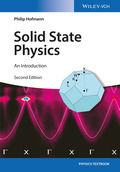Solid State Physics
An Introduction

2. Auflage April 2015
XVI, 258 Seiten, Softcover
110 Abbildungen
15 Tabellen
Lehrbuch
Kurzbeschreibung
Eine klar strukturierte und prägnante Einführung in das Thema. Neben allen grundlegenden Phänomenen und Konzepten werden auch schwierigere Themen wie Magnetismus und Supraleitfähigkeit behandelt. Setzt nur Grundlagenwissen in Mathematik voraus.
A must-have textbook for any undergraduate studying solid state physics.
This successful brief course in solid state physics is now in its second edition. The clear and concise introduction not only describes all the basic phenomena and concepts, but also such advanced issues as magnetism and superconductivity. Each section starts with a gentle introduction, covering basic principles, progressing to a more advanced level in order to present a comprehensive overview of the subject. The book is providing qualitative discussions that help undergraduates understand concepts even if they can?t follow all the mathematical detail.
The revised edition has been carefully updated to present an up-to-date account of the essential topics and recent developments in this exciting field of physics. The coverage now includes ground-breaking materials with high relevance for applications in communication and energy, like graphene and topological insulators, as well as transparent conductors.
The text assumes only basic mathematical knowledge on the part of the reader and includes more than 100 discussion questions and some 70 problems, with solutions free to lecturers from the Wiley-VCH website. The author's webpage provides Online Notes on x-ray scattering, elastic constants, the quantum Hall effect, tight binding model, atomic magnetism, and topological insulators.
This new edition includes the following updates and new features:
* Expanded coverage of mechanical properties of solids, including an improved discussion of the yield stress
* Crystal structure, mechanical properties, and band structure of graphene
* The coverage of electronic properties of metals is expanded by a section on the quantum hall effect including exercises. New topics include the tight-binding model and an expanded discussion on Bloch waves.
* With respect to semiconductors, the discussion of solar cells has been extended and improved.
* Revised coverage of magnetism, with additional material on atomic magnetism
* More extensive treatment of finite solids and nanostructures, now including topological insulators
* Recommendations for further reading have been updated and increased.
* New exercises on Hall mobility, light penetrating metals, band structure
CRYSTAL STRUCTURES
General Description of Crystal Structures
Some Important Crystal Structures
Crystal Structure Determination
Further Reading
Discussion and Problems
BONDING IN SOLIDS
Attractive and Repulsive Forces
Ionic Bonding
Covalent Bonding
Metallic Bonding
Hdrogen Bonding
van der Waals Bonding
Further Reading
Discussion and Problems
MECHANICAL PROPERTIES
Elastic Deformation
Plastic Deformation
Fracture
Further Reading
Discussion and Problems
THERMAL PROPERTIES OF THE LATTICE
Lattice Vibrations
Heat Capacity of the Lattice
Thermal Conductivity
Thermal Expansion
Allotropic Phase Transitions and Melting
Further Reading
Discussion and Problems
ELECTRONIC PROPERTIES OF METALS: CLASSICAL APPROACH
Basic Assumptions of the Drude Model
Results from the Drude Model
Shortcomings of the Drude Model
Further Reading
Discussion and Problems
ELECTRONIC PROPERTIES OF SOLIDS: QUANTUM MECHANICAL APPROACH
The Idea of Energy Bands
Free Electron Model
The General Form of the Electronic States
Nearly Free Electron Model
Tight-Binding Model
Energy Bands in Real Solids
Transport Properties
Brief Review of Some Key Ideas
Further Reading
Discussion and Problems
SEMICONDUCTORS
Intrinsic Semiconductors
Doped Semiconductors
Conductivity and Semiconductors
Semiconductor Devices
Further Reading
Discussion and Problems
MAGNETISM
Macroscopic Description
Quantum Mechaical Description of Magnetism
Paramagnetism and Diamagnetism in Atoms
Weak Magnetism in Solids
Magnetic Ordering
Further Reading
Discussion and Problems
DIELECTRICS
Macroscopic Description
Microscopic Polarization
The Local Field
Frequency Dependence of the Dielectric Constant
Other Effects
Further Reading
Discussion and Problems
SUPERCONDUCTIVITY
Basic Experimental Facts
Some Theoretical Aspects
Experimental Detection of the Gap
Coherence of the Superconducting State
Type I and Type II Superconductors
High-Temperature Superconductivity
Concluding Remarks
Further Reading
Discusson and Problems
FINITE SOLIDS AND NANOSTRUCTURES
Quantum Confinement
Surfaces and Interfaces
Magnetism on the Nanoscale
Further Reading
Discussion and Problems
APPENDIX
Explicit Forms of Vector Operations
Differential Form of the Maxwell Equations
Maxwell Equations in Matter
Index
B. Jacoby, European Journal of Physics 30, 919


